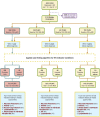Missed opportunities for earlier diagnosis of HIV in British Columbia, Canada: A retrospective cohort study
- PMID: 30897143
- PMCID: PMC6428302
- DOI: 10.1371/journal.pone.0214012
Missed opportunities for earlier diagnosis of HIV in British Columbia, Canada: A retrospective cohort study
Abstract
Background: Late HIV diagnosis is associated with increased AIDS-related morbidity and mortality as well as an increased risk of HIV transmission. In this study, we quantified and characterized missed opportunities for earlier HIV diagnosis in British Columbia (BC), Canada.
Design: Retrospective cohort.
Methods: A missed opportunity was defined as a healthcare encounter due to a clinical manifestation which may be caused by HIV infection, or is frequently present among those with HIV infection, but no HIV diagnosis followed within 30 days. We developed an algorithm to identify missed opportunities within one, three, and five years prior to diagnosis. The algorithm was applied to the BC STOP HIV/AIDS population-based cohort. Eligible individuals were ≥18 years old, and diagnosed from 2001-2014. Multivariable logistic regression identified factors associated with missed opportunities.
Results: Of 2119 individuals, 7%, 12% and 14% had ≥1 missed opportunity during one, three and five years prior to HIV diagnosis, respectively. In all analyses, individuals aged ≥40 years, heterosexuals or people who ever injected drugs, and those residing in Northern health authority had increased odds of experiencing ≥1 missed opportunity. In the three and five-year analysis, individuals with a CD4 count <350 cells/mm3 were at higher odds of experiencing ≥1 missed opportunity. Prominent missed opportunities were related to recurrent pneumonia, herpes zoster/shingles among younger individuals, and anemia related to nutritional deficiencies or unspecified cause.
Conclusions: Based on our newly-developed algorithm, this study demonstrated that HIV-diagnosed individuals in BC have experienced several missed opportunities for earlier diagnosis. Specific clinical indicator conditions and population sub-groups at increased risk of experiencing these missed opportunities were identified. Further work is required in order to validate the utility of this proposed algorithm by establishing the sensitivity, specificity, positive and negative predictive values corresponding to the incidence of the clinical indicator conditions among both HIV-diagnosed and HIV-negative populations.
Conflict of interest statement
JSGM has received institutional grants from Gilead Sciences, J&J, Merck, ViiV Healthcare, and a Knowledge Translation Award from the Canadian Institutes of Health Research. JSGM has also served as an advisor to Government of Canada and the Government of British Columbia in the last year. All other authors declare no competing interests. This does not alter our adherence to PLOS ONE policies on sharing data and materials. However, the British Columbia Centre for Excellence in HIV/AIDS is prohibited from making individual-level data available publicly due to provisions in our service contracts, institutional policy, and ethical requirements. In order to facilitate research we make such data available via data access requests. Some BC-CfE data is not available externally due to prohibitions in service contracts with our funders or data providers. Institutional policies stipulate that all external data requests require collaboration with a BC-CfE research. For more information or to make a request, please contact Irene Day, Senior Director, Internal and External Relations and Strategic Development: iday@cfenet.ubc.ca.
Figures
Similar articles
-
Late presentations and missed opportunities among newly diagnosed HIV patients presenting to a specialty clinic in Lebanon.Sci Rep. 2024 Apr 9;14(1):8296. doi: 10.1038/s41598-024-55277-1. Sci Rep. 2024. PMID: 38594292 Free PMC article.
-
Missed Opportunities for HIV Diagnosis and Their Clinical Repercussions in the Portuguese Population-A Cohort Study.Pathogens. 2024 Aug 13;13(8):683. doi: 10.3390/pathogens13080683. Pathogens. 2024. PMID: 39204283 Free PMC article.
-
Prevalence of HIV indicator conditions in late presenting patients with HIV: a missed opportunity for diagnosis?QJM. 2019 Jan 1;112(1):17-21. doi: 10.1093/qjmed/hcy223. QJM. 2019. PMID: 30295832
-
Late presentation to HIV care despite good access to health services: current epidemiological trends and how to do better.Swiss Med Wkly. 2016 Aug 21;146:w14348. doi: 10.4414/smw.2016.14348. eCollection 2016. Swiss Med Wkly. 2016. PMID: 27544642 Review.
-
Missed CANDOR Implementation Opportunities.2022 Nov 16. In: WebM&M: Case Studies [Internet]. Rockville (MD): Agency for Healthcare Research and Quality (US); 2019 Oct 30–. 2022 Nov 16. In: WebM&M: Case Studies [Internet]. Rockville (MD): Agency for Healthcare Research and Quality (US); 2019 Oct 30–. PMID: 40700558 Free Books & Documents. Review. No abstract available.
Cited by
-
HIV testing in a high prevalence urban area in the US: Identifying missed opportunities two ways.Int J STD AIDS. 2022 Oct;33(11):970-977. doi: 10.1177/09564624221118484. Epub 2022 Aug 27. Int J STD AIDS. 2022. PMID: 36031933 Free PMC article.
-
Avantages du dépistage opportuniste des infections transmissibles sexuellement en médecine de soins primaires.CMAJ. 2021 May 10;193(19):E710-E712. doi: 10.1503/cmaj.210604-f. CMAJ. 2021. PMID: 33972232 Free PMC article. French. No abstract available.
-
Refractory HIV-Associated Guillain-Barré Syndrome Responsive to Antiretroviral Therapy: A Case Report.Case Rep Infect Dis. 2024 Nov 20;2024:7292001. doi: 10.1155/crdi/7292001. eCollection 2024. Case Rep Infect Dis. 2024. PMID: 39619280 Free PMC article.
-
Disparities in multimorbidity and mortality among people living with and without HIV across British Columbia's health regions: a population-based cohort study.Can J Public Health. 2021 Dec;112(6):1030-1041. doi: 10.17269/s41997-021-00525-4. Epub 2021 Aug 30. Can J Public Health. 2021. PMID: 34462891 Free PMC article.
-
Analysing Early Diagnosis Strategies for HIV Infection: A Retrospective Study of Missed Diagnostic Opportunities.Healthcare (Basel). 2024 Jan 31;12(3):361. doi: 10.3390/healthcare12030361. Healthcare (Basel). 2024. PMID: 38338246 Free PMC article.
References
Publication types
MeSH terms
Grants and funding
LinkOut - more resources
Full Text Sources
Medical
Research Materials


